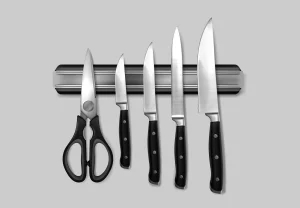During the last few years the popularity of silicone utensils has increased considerably. And it is not surprising with all the advantages that this material offers.
But what are these utensils made of, and are they safe to use in the kitchen?
After all, other quite popular materials also have their disadvantages and require certain care to ensure the wholesomeness and integrity of our food.
In this post we will help you answer all your questions about silicone utensils.
What is silicone?
Silicone is a synthetic polymer, renowned for its versatility and widespread use in a variety of applications. It’s made from silicon, a naturally occurring element, combined with oxygen, carbon, hydrogen, and sometimes other elements.
This composition gives silicone its unique properties: it’s heat-resistant, rubber-like, and highly durable. Unlike plastics, which are primarily derived from petroleum, silicone is made using silica, commonly found in sand.
All this has made it a popular choice in kitchenware. Silicone’s flexible, non-stick nature, along with its stability at high temperatures, has made it a favored material in the culinary world, especially for utensils and bakeware.
Benefits of silicone utensils
Silicone kitchen utensils offer several advantages that make them a preferred choice in modern kitchens.
- Heat resistance: one of the most significant benefits of silicone utensils is their exceptional heat resistance. They can typically withstand temperatures ranging from -40 to 450 degrees Fahrenheit. This makes them safe for use in cooking and baking without the risk of melting or warping.
- Non-stick and easy to clean: silicone’s smooth surface ensures that food doesn’t stick, making both cooking and cleaning easier. These utensils can be easily cleaned by hand with soap and water or in a dishwasher.
- Durability: silicone utensils are known for their durability. They are less prone to damage and wear compared to their plastic or wooden counterparts. They don’t crack, chip, or become brittle over time.
- Hygienic and safe: silicone is non-porous, which means it doesn’t harbor bacteria or odors. This makes silicone utensils more hygienic compared to other materials that may retain smells or flavors.
- Flexibility: the flexibility of silicone makes these utensils gentle on cookware surfaces, reducing the risk of scratching pots and pans, especially those with non-stick coatings.
- Chemical stability: silicone remains stable and doesn’t leach chemicals into food, even at high temperatures. This property makes it a safe choice for cooking utensils.
Are silicone utensils safe for Food?
The safety of silicone utensils for food preparation is a common concern, and it’s important to understand the facts. Silicone, when manufactured properly, is generally considered safe for food contact.
- FDA Approval: high-quality silicone utensils are often made from food-grade silicone, which is approved by the Food and Drug Administration (FDA) for contact with food. This means it doesn’t contain any harmful chemicals that can leach into food.
- Stability Under Heat: silicone’s heat-resistant properties make it stable even at high temperatures. This means it doesn’t melt, warp, or degrade easily, minimizing the risk of contaminating food with particles or chemicals.
- Non-Toxic and Inert: silicone is non-toxic and chemically inert. It doesn’t react with food or beverages or produce any hazardous fumes, ensuring that it’s safe for food preparation tasks.
However, it’s crucial to ensure that you are using high-quality, food-grade silicone. Lower quality silicone products may contain fillers or additives that can compromise their safety. To test for purity, you can pinch and twist a flat surface of the utensil. If white shows through, it might contain fillers.
Is silicone utensils safer than Plastic?
Silicone is chemically stable and doesn’t leach harmful substances into food. In contrast, certain plastics can release chemicals like BPA or phthalates, especially when heated or scratched. Although many modern plastics are BPA-free, silicone still offers greater stability and peace of mind.
Although both materials are not biodegradable, silicone is considered a more environmentally friendly option compared to single-use or low-quality plastic utensils that contribute to plastic waste.
Can you microwave silicone?
Yes, you can safely microwave silicone. High-quality, food-grade silicone is designed to be microwave safe, capable of withstanding the heat generated in a microwave without melting or warping. Unlike some plastics that can release toxic fumes or chemicals when heated, silicone maintains its integrity and doesn’t compromise the safety or quality of your food.
However, it’s always prudent to check the manufacturer’s instructions before microwaving any silicone product. This is because some silicone items might have specific design elements or added materials that could affect their suitability for microwave use.
An added advantage of microwaving with silicone is its heat resistance, which means the container won’t become excessively hot, although the food or liquid inside may be significantly hotter. In essence, silicone offers a convenient and safe option for microwave heating and cooking, aligning well with modern culinary needs.
How to clean silicone utensils?
Cleaning silicone utensils and cookware is straightforward and easy, thanks to their non-stick and stain-resistant nature. Here’s how you can effectively clean your silicone items:
- Rinse with Water: start by rinsing your silicone utensils under warm water to remove any loose food particles.
- Use soap and water: Apply a gentle dish soap to the silicone. You can use a soft sponge or cloth to scrub it. Due to its non-stick surface, food and grease should come off easily without the need for aggressive scrubbing.
- Dishwasher safe: One of the great advantages of silicone is that most items are dishwasher safe. You can place them in the top rack of your dishwasher for a thorough clean.
- Tackling tough stains: If you encounter tough stains or odors, baking soda can be an effective cleaning agent. Make a paste of baking soda and water, apply it to the stained areas, and let it sit for a few minutes before washing off.
- Drying: After washing, silicone utensils can be air-dried or wiped with a clean towel. Silicone doesn’t hold water, so it dries quickly.
- Avoid sharp objects: While cleaning, avoid using sharp objects or abrasive pads on silicone, as they can damage the surface.
Check out the silicone utensils we have in Sylarb
Here are some of our most popular silicone cookware:




